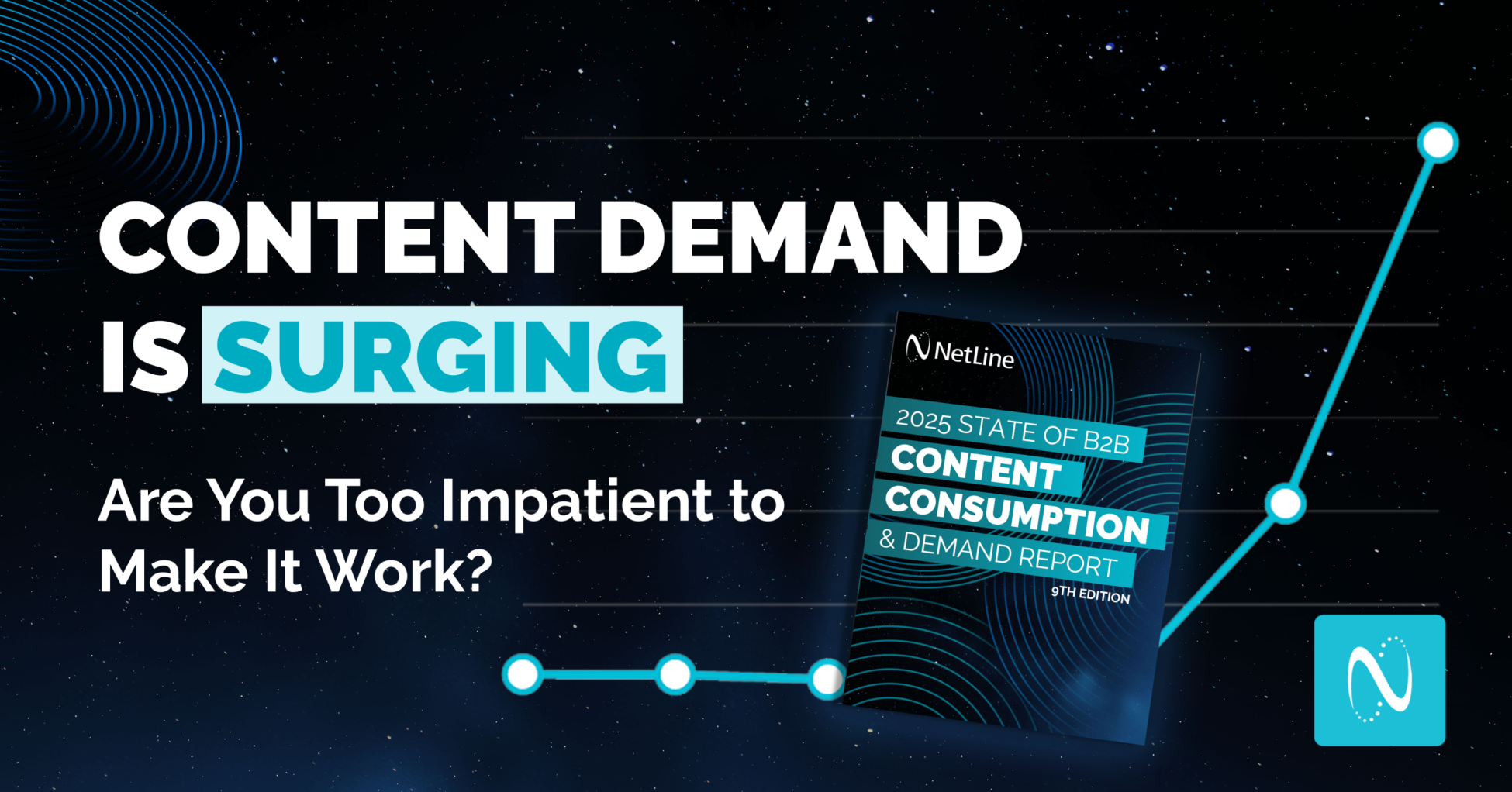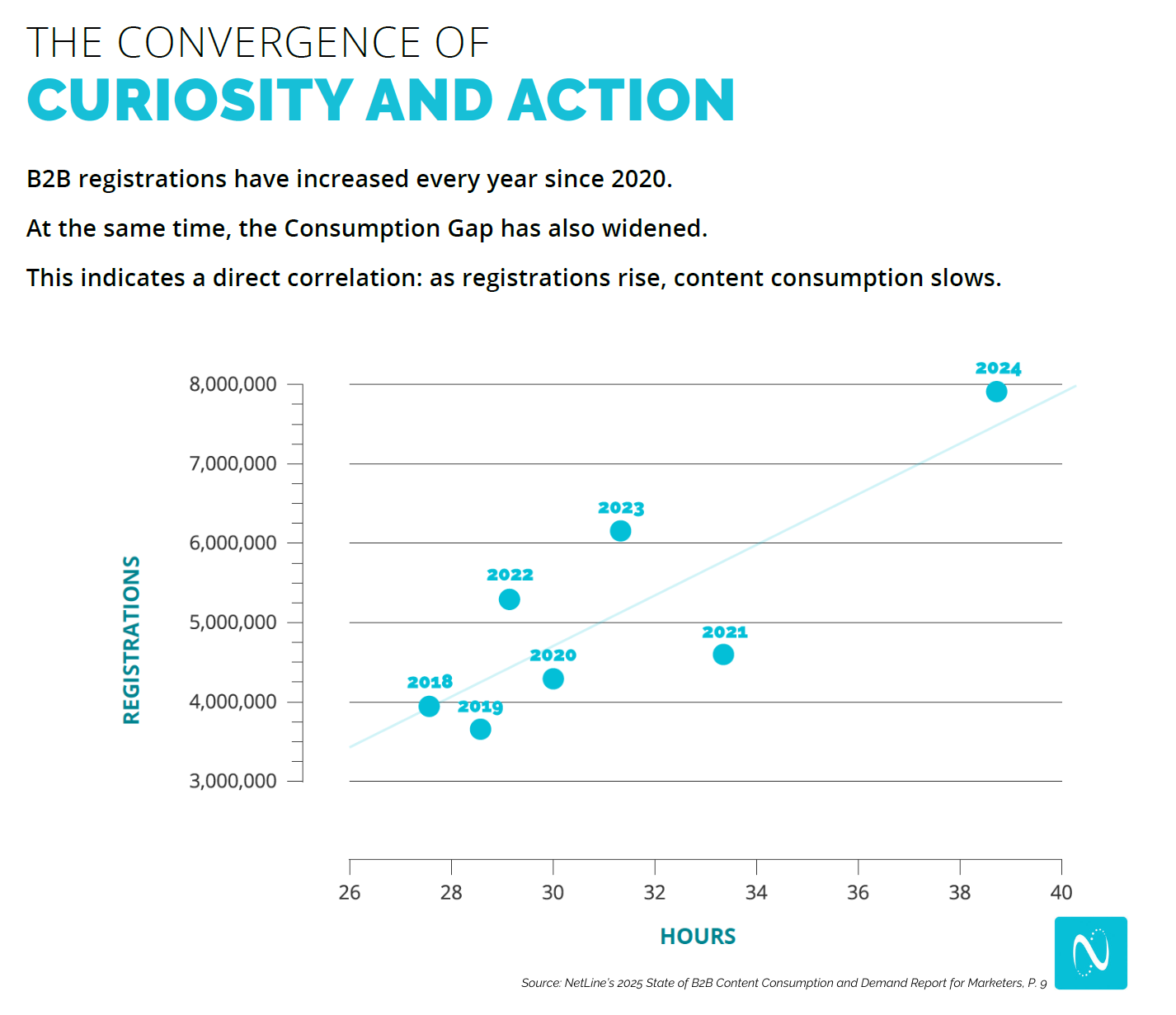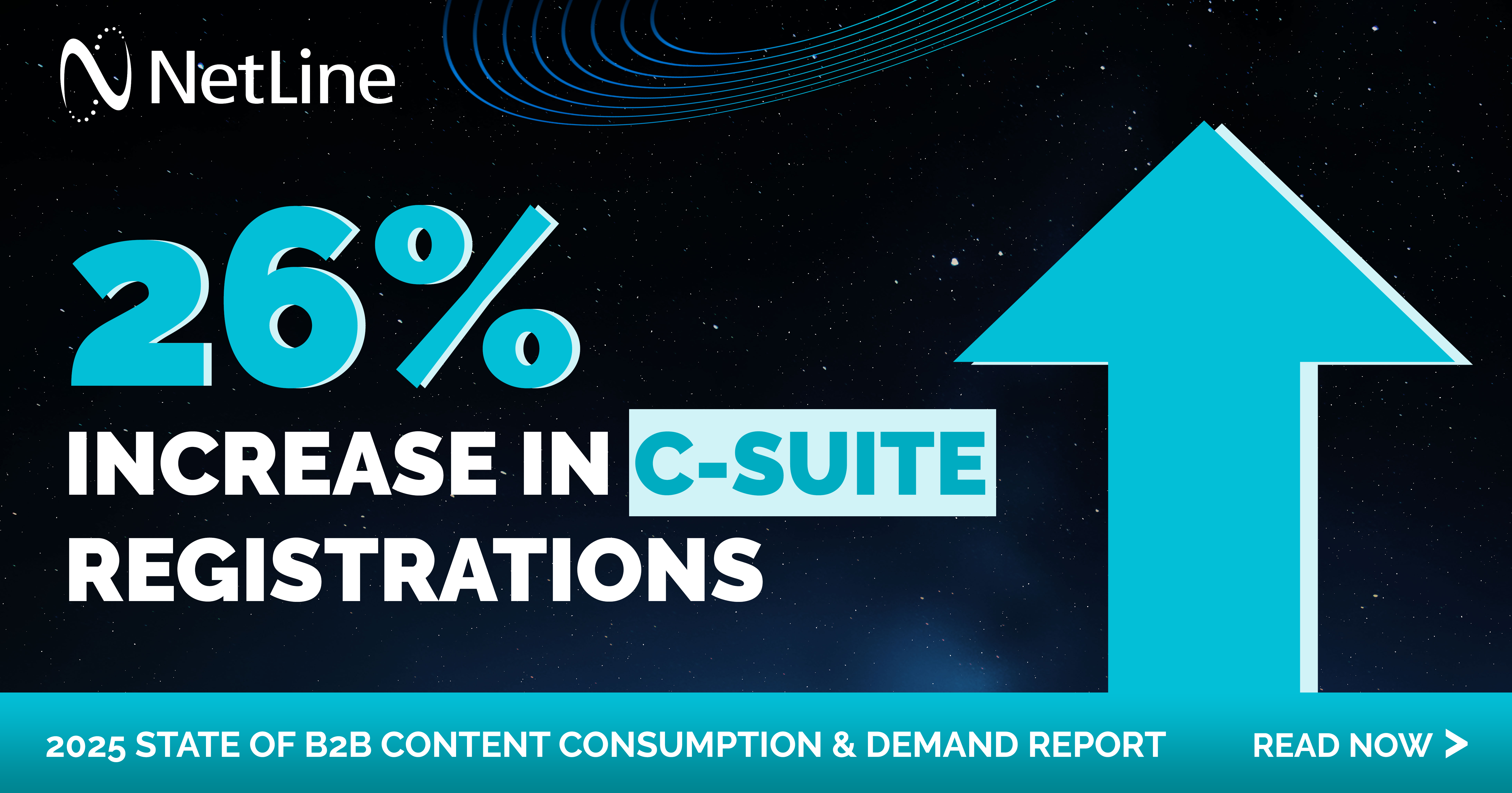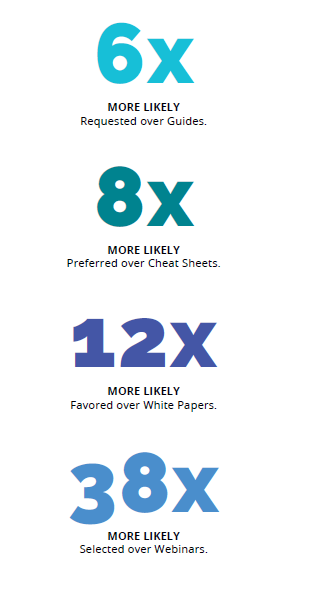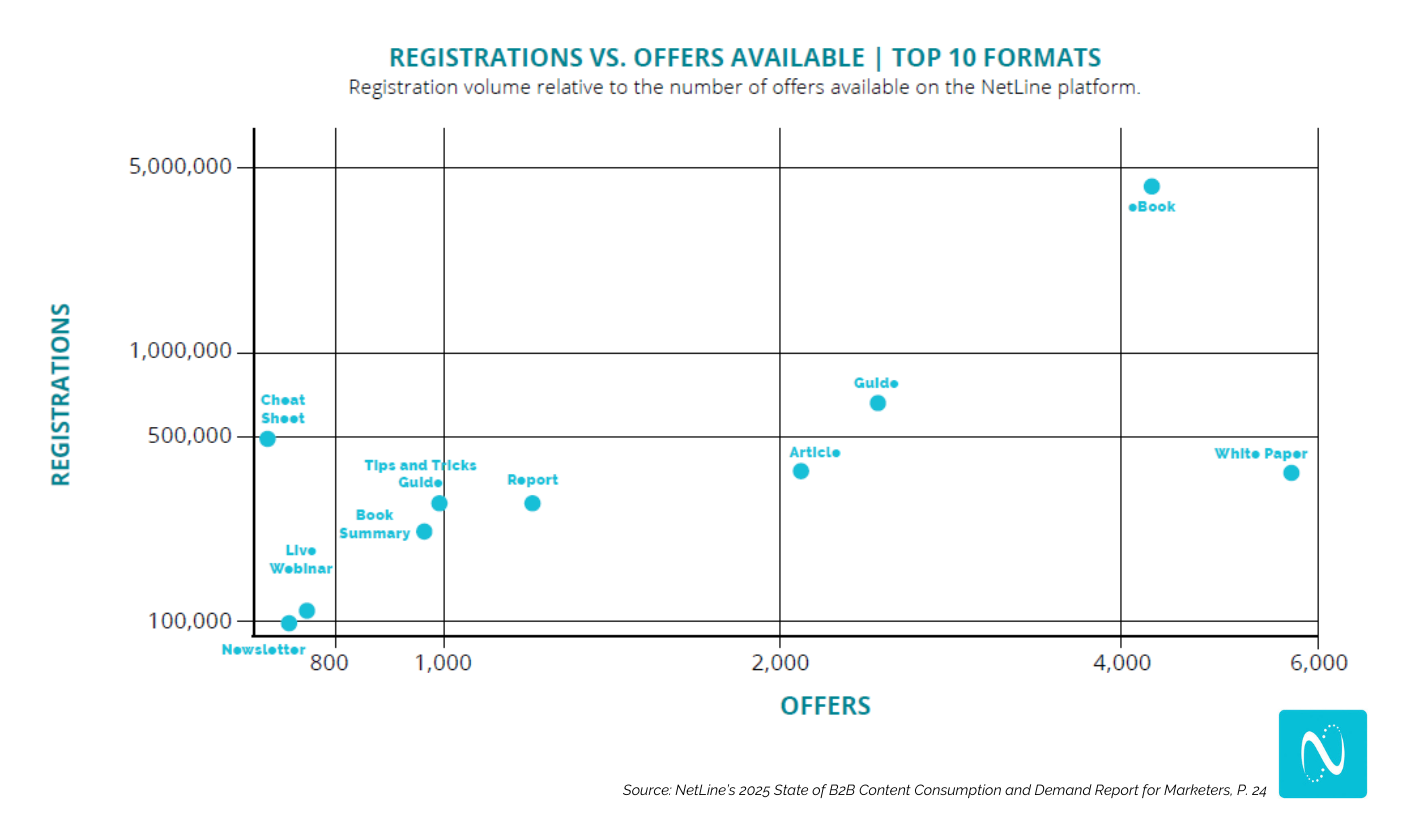What do people want?
What do people do?
Despite literal yottabytes of data constantly flying around us, many marketers feel they don’t really understand what their target audiences want or do.
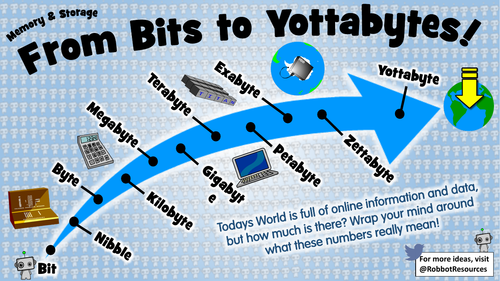
Source: tes.com
And that’s troubling.
So how do we solve this?
Simply, to identify what our audiences wants, we must understand what they are already doing.
Enter NetLine’s 9th annual State of B2B Content Consumption and Demand Report—an in-depth, first-party analysis of how professionals interact with content and what their actions reveal about intent.
Introducing NetLine’s 2025 State of B2B Content Consumption and Demand Report
“The more things change, the more they stay the same.” – Jean-Baptiste Alphonse Karr
In 2024, 7.9 million first-party registrations revealed that much of the same remains true in B2B.
[ Access the 2025 State of B2B Content Consumption and Demand Report.]
Yes, buyer behaviors are shifting, AI is reshaping our professional lives, and B2B professionals require more from their content than ever.
However, 2024’s retrospective looks an awful lot like 2023.
- Content demand grew 26.9% year over year—a testament to the growing appetite for gated content and the treasure trove of intent signals it unlocks.
- There’s a Catch 22. The time it takes to consume content has widened.
- This is called The Consumption Gap, and it has grown 23.3% over the last year.
- Want to know who is most likely to make a purchase decision in the next 12 months? Produce a Playbook.
- Compared to other formats, users registering for this content are 115.1% more likely to make a purchase at this time.
- eBooks continue to be a truly dominant format force across all Job Levels, Industries, and Roles.
But just because what we’ve discovered is similar, it doesn’t mean the takeaways are the same.
What we discovered provides a roadmap for thriving in today’s intent-driven ecosystem.
5 Game-Changing Insights from the 2025 State of B2B Content Consumption and Demand Report
Below, we’ll explore five key findings that will redefine how you think about content marketing in 2025.
1. Timing is…
Everything.
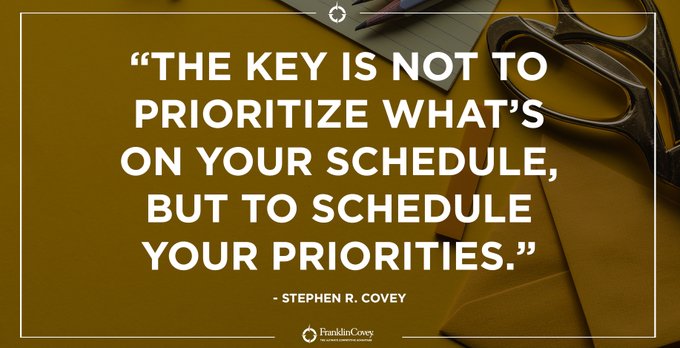
Source: Stephen Covey
We began by asking what people want.
Once we work our way through Maslow’s Hierarchy of Needs, what people crave is time.
Money, theoretically, is infinite. Time is finite.
In 2024, the Consumption Gap—the delay between content registration and consumption—reached 38.5 hours, widening by 7.3 hours year over year.
So, while content consumption rates have never been higher, the speed at which content is consumed has never been slower.
This metric reflects more than hesitation; it reveals the competing priorities and overload that today’s buyers face.
The bottom line? When you begin your outreach, matters.
2. The Tortoise and the Hare
So what do we do with this information around timing?
Many marketing teams still run follow-up sequences as if nothing has changed.
And it’s costing you money.
Here’s an example:
Your marketing automation fires off a follow-up email within minutes of a lead hitting your CRM. Your SDR calls within the hour.
But your prospect? They haven’t even opened your content yet.
From their perspective, they haven’t started the conversation. So when your email lands—or your sales rep dials—it feels off.
The timing isn’t just wrong; it’s disruptive.
Actions like this result in:
- Ignored emails
- Unsubscribes
- Lower conversion rates
Fast follow-ups used to work. (However, if they’ve specifically asked for contact, don’t wait!)
But today, relevance without readiness just creates friction.
Marketing Aikido
What’s obvious is that our nurturing strategies must adapt.
Instead of worrying about the lag in consumption, we should be taking advantage of this behavior. Provide timely summaries and follow-ups that respect and embrace the slowdown.
Providing these tools to your sales colleagues will be extremely useful and, based on average B2B user behavior, will likely be appreciated by the recipient.
For sellers, apply both caution and context to any outreach.
Before any outreach to your new registrant, review the content they’ve just requested and share whatever quick-hitting synopses and actionable takeaways you have available for their chosen asset.
This allows you to accomplish the following:
- Say hello without any aggressive demo/sales request
- Establish a connection with a registrant
- Add additional value
We must also recognize the role Format Intent plays for each registration.
For example, a user registering for a Playbook should be engaged more swiftly than a user requesting an eBook.
Why? Because for every Playbook request in 2024, there were 50 eBook requests—making the registration of a Playbook an exceptionally rare choice (and often with significant purchase intent).
[More on this in “The eBook Empire”.]
3. C-Level Engagement Surges by 26.5%
For the first time since 2022, C-Level professionals ranked as the second-largest audience, accounting for 12.7% of total registrations.
For marketing departments, this growth should be celebrated. C-Level reach is something most campaigns hope to achieve. Not only are these professionals eager to consume, but they’re also looking to consume the same formats as their team members.
C-Level professionals want access to easy-to-consume content. (There’s a reason why Executive Summaries exist.) Their time is limited and, therefore, must squeeze the most from any time investment.
So while we want to engage the C-Level because of their financial sway, remember that they are people with the same amount of time in their day as anyone else.
4. AI Content Demand Grew 186%
Artificial intelligence is now a cornerstone of professional curiosity and production.
In 2024, demand for AI-related content skyrocketed by 186%, led by interest in topics like generative AI (up 493%) and regulatory concerns among legal professionals.
Specifically, this increase in overall demand signals a critical opportunity to craft AI-focused narratives tailored to diverse industries—from biotech’s fascination with NLP to finance’s embrace of automation.
“Generative AI” content registrations grew 5x year-over-year with industries like Banking/Mortgage and Marketing driving this wave. Meanwhile, Journalism’s curiosity about tools like “ChatGPT” highlight how professionals are leveraging AI to unlock creativity and streamline workflows.
The takeaway for marketers is to meet your audience where they are (and where they are going).
Whether it’s speaking to Agriculture’s appetite for “Chatbot” solutions or showcasing the potential of “Robotics” to Executives, the key to success lies in tailoring your messaging to the specific needs of your target audience.
Marketers who align their strategies with these interests will not only grab attention but establish themselves as trusted voices in the AI craziness.
5. The eBook Empire
The 2025 State of B2B Content Consumption and Demand Report paints a compelling picture of the dominance of eBooks as the go-to format for B2B professionals.
Accounting for 53.3% of all demand in 2024, eBook registrations skyrocketed by 71.4% year-over-year, far outpacing any other content format.
Compared to Guides, eBooks outperformed the second most popular format by registration volume by a staggering 572%.
Moreover, the efficiency of eBooks is unmatched.
Each asset uploaded to the NetLine platform generates an average of 983 registrations, eclipsing White Papers’ 59.5 registrations per asset.
These stats underscore eBooks’ unique ability to balance depth, accessibility, and user engagement.
eBooks’ dominance reveals a preference for comprehensive resources that blend rich insights with convenience, making them a cornerstone of top-of-funnel awareness campaigns.
The caveat with this format is that its popularity does not match its intent signal. Compared to other formats like playbooks and case studies, eBooks were 11.8% less likely to drive buying decisions within a year.
But that’s okay.
Every format has a purpose. If your ICP is requesting eBooks, that’s a good thing. They are simply at the top of the funnel and just beginning their journey. Your job is to introduce your business’s expertise in these eBooks and educate throughout your nurture program.
To capitalize fully, marketers must strategically pair eBooks with high-intent formats in their content arsenal, ensuring their campaigns not only spark interest but also have the opportunity to drive conversion.
Why Building Intentional Content Experiences is Critical
We’ve highlighted five of the most interesting learnings from NetLine’s annual B2B content consumption report.
So what comes next?
What should everyone do with this information?
In (re)analyzing the entirety of the 2025 report, one massive thought comes to mind:
B2B content marketers and teams must shift their focus from simply creating more content to orchestrating smarter, more intentional content experiences.
The insights are clear—buyers are overwhelmed.
The widening Consumption Gap (38.5 hours!) is proof that audiences need time, space, and relevance to engage meaningfully.
For marketers, we can’t afford to treat content as a volume game. Instead, we must craft assets that align with specific moments in the buyer’s journey—content that respects their timeline, answers their immediate questions, and gently guides them forward.
The dominance of eBooks and the rise of AI-related content show that while curiosity abounds, purchase intent often lies deeper in the funnel.
Formats like Case Studies and Playbooks—which are strongly tied to purchase decisions—remind us of the importance of balancing top-of-funnel discovery with bottom-of-funnel precision.
In 2025, teams that thrive will prioritize:
- Smarter Follow-Ups: Respect the time it takes to engage with the content they’ve requested. Want to follow up before the 48-hour window? Be absolutely sure you have contextually relevant messaging.
- Format-Specific Strategies: eBooks need to be your loss-leader. They need to be the content that gets your ICP in the door. From there, use intent-rich formats like Playbooks when targeting buyers close to a decision, while feeding discovery and brand-building efforts.
- Hyper-Personalization with Intent Data: This is the year of data-driven empathy. NetLine’s audience intent data offers a window into what your audience wants—leverage it to deliver personalized, human-first experiences. In an AI-world, this will separate good marketers from great ones.
Using NetLine’s Research to Fix the Broken Demand Generation Playbook
Buyers aren’t ignoring outreach because they aren’t interested; they’re ignoring it because they aren’t ready.
Pushing too soon leads to lower response rates, more no-shows, and increased frustration for both buyers and sales teams.
Remember: your timeline is not their timeline.
The most effective teams in 2025 won’t simply move faster; they’ll move smarter. Precision will win over speed, and the companies that adapt now will be the ones leading the charge into the future.
Be deliberate.
Prioritize actual engagement behaviors, such as nurturing emails that deliver actionable takeaways and synopses and Sales tracking real intent signals instead of relying on outdated MQL definitions.
Different content types reflect different levels of interest—eBooks drive awareness, White Papers indicate deeper research, and Playbooks are strong buying signals.
Every word, format, and interaction should contribute to a thoughtful, empathetic content strategy that prioritizes quality over quantity and impact over noise.
This report isn’t just about trends—it’s a blueprint for connection in a world that desperately needs it.
What Surprised You Most?
As you explore this year’s findings, we’d love to hear your thoughts. What surprised you most? How do you plan to adapt your strategy based on this data?
Tag NetLine on LinkedIn with your reflections and questions—we’re here to collaborate and learn together.
Ready to dive deeper? Access the full 2025 State of B2B Content Consumption and Demand Report.
